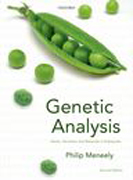
The logic and strategy of genetic analysis in one semester. Applies the combined power of molecular biology, genetics, and genomics to solve biological questions. Uses established principles of genetics as methods to analyse larger problems in biology. Illustrates the concepts of key analytical tools with carefully selected examples from a range of model organisms, and encourages the reader to look beyond the examples to see how these tools apply to a wide range of biological problems. Covers the latest and most powerful experimental tools to provide a state-of-the-art review of the field, giving insights into gene networks and interactions. Text boxes and extended case studies enable the reader to fully get to grips with how genetic tools can be used to understand biological systems. The Online Resource Centre features additional materials for teachers and students, enhancing the educational value of the text. New to this edition A new chapter in Unit I, Genomes, Chromosomes, and Epigenetics, places the genome into the context of chromosome structure, with discussion of epigenetics and ENCODE. Unit II has been substantially revised in light of the availability of whole genomes, with examples of exome sequencing and genome-wide mutant screens thoroughly discussed. Unit III comprises three new chapters dealing with genome-wide association studies, complex traits, and the genetic structure of natural populations. Unit IV now includes a discussion of genome-wide analysis of gene interactions in yeast, as well as a new chapter focusing on the relationship between genotype and phenotype in the context of personal genomics. Coverage of human genetics has been expanded with further examples from human genetic diversity and disease, reflecting the enormous advances made in these areas. Further reading sections are now included at the end of chapters, to offer guidance to those wishing to explore a topic in more depth. Study questions, designed to be used alongside chapters and to offer different levels of challenge, have been added to the Online Resource Centre. How do we know what role a particular gene has? How do some genes control the expression of others? How do genes interact to form gene networks? With its unique integration of genetics and molecular biology, Genetic Analysis probes fascinating questions such as these, detailing how our understanding of key genetic phenomena can be used to understand biological systems. Opening with a brief overview of key genetic principles, model organisms, and epigenetics, the book goes on to explore the use of gene mutations and the analysis of gene expression and activity. A discussion of the genetic structure of natural populations follows, before the interaction of genes during suppression and epistasis, how we study gene networks, and personalized genomics are considered. Drawing on the latest experimental tools, including microarrays, RNAi screens, and bioinformatics approaches, Genetic Analysis provides a state-of-the-art review of the field, but in a truly student-friendly manner. It uses extended case studies and text boxes to augment the narrative, taking the reader right to the forefront of contemporary research, without losing clarity of explanation and insight. We are in an age where, despite knowing so much about biological systems, we are just beginning to realise how much more there is still to understand. Genetic Analysis is the ideal guide to how we can use the awesome power of molecular genetics to further our understanding. Online Resource Centre The Online Resource Centre to accompany Genetic Analysis features the following resources for teachers and students: For students: · Topical updates - key updates on topics or tools presented in the book, to keep you up-to-date with the latest developments in the field. · Additional case studies and text boxes to complement and add to those found in the book. · Practice problems, to test the reader's knowledge of the concepts presented, and help to master them. For registered adopters of the book: · Figures from the book in electronic format, ready to download. · Journal clubs - suggested papers and discussion questions linked to topics covered in the book.
- ISBN: 978-0-19-965181-8
- Editorial: OXFORD UNIVERSITY PRESS.
- Encuadernacion: Rústica
- Páginas: 580
- Fecha Publicación: 10/07/2014
- Nº Volúmenes: 1
- Idioma:
